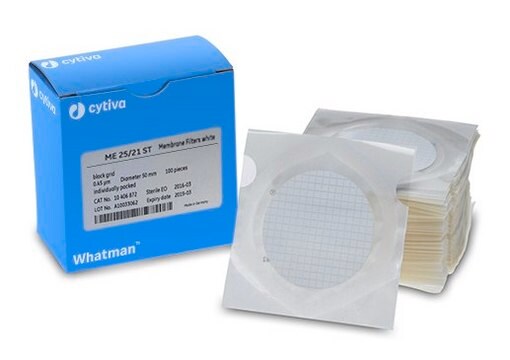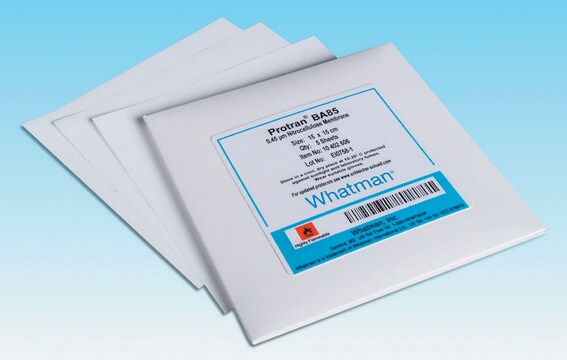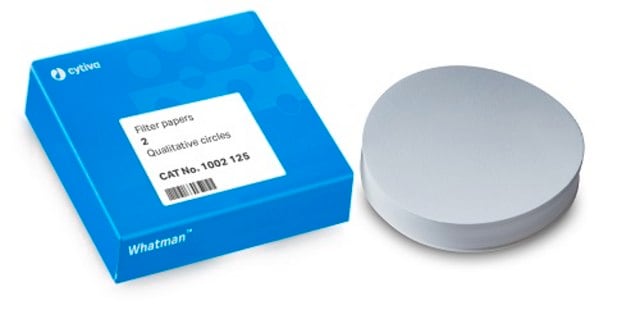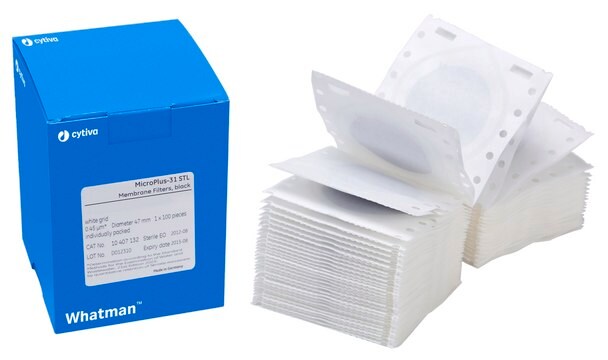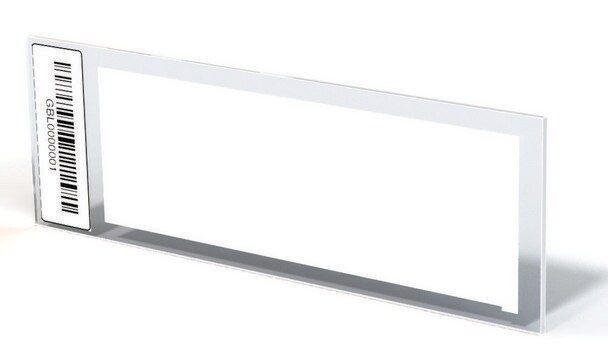WHA7141004
Whatman® mixed cellulose ester membrane filters
gridded white, pore size 0.45 μm, diam. 47 mm, pack of 100 ea
Sinónimos:
Whatman® nitrocellulose membrane filters, Whatman filter, Z745820, membrane filters, syringe filter
About This Item
Productos recomendados
Materiales
gridded white
esterilidad
non-sterile
envase
pack of 100 ea
fabricante / nombre comercial
Whatman 7141-004
Whatman Article No. 28420718 (US reference)
Diámetro
47 mm
tamaño de poro
0.45 μm
¿Está buscando productos similares? Visita Guía de comparación de productos
Categorías relacionadas
Descripción general
Higher strength and flexibility:
Most membranes are inherently brittle and difficult to handle; it is not uncommon for filters to be damaged during loading into holders or while in use. Whatman mixed cellulose ester membrane filters have a noticeably improved flexibility and are made to tolerate abuse during handling, loading and autoclaving without sacrificing integrity. These membranes are among the strongest of their type available, as measured and compared by burst pressure tests.
Low extractable levels:
The level of extractables in membrane filters has become more important with advances in filtration or adsorption techniques. In particular, pharmaceutical, immunological and biomedical tissue culture and trace analysis applications can be adversely affected by high extractable levels. Whatman mixed cellulose ester membrane filters have a low level of extractables, generally below that of other membranes of a similar type.
Narrow pore size distribution:
One of the major features of Whatman membrane filters is the narrow distribution of pore sizes. The rated pore size of these membranes is closely controlled due to the advanced manufacturing and control system. Additionally, the batch-to-batch variation is minimized providing more consistent laboratory results.
Increased temperature stability:
Membrane filters are normally autoclaved at 121°C without loss of integrity. Cellulose nitrate membranes are supplied as circles, sheets or reels.
Reduced shrinkage:
Excessive shrinkage can cause problems during autoclaving and is often the cause of membranes tearing in their holders after autoclaving. It may also cause a reduction in flow rate and total throughput. Whatman membranes exhibit a low shrinkage during autoclaving.
Applications:
Sample preparation
Microbiological studies
Filtration of aqueous solutions
Higher strength and flexibility:
Most membranes are inherently brittle and difficult to handle; it is not uncommon for filters to be damaged during loading into holders or while in use. Whatman cellulose nitrate membrane filters have a noticeably improved flexibility and are made to tolerate abuse during handling, loading and autoclaving without sacrificing integrity. These membranes are among the strongest of their type available, as measured and compared by burst pressure tests.
Low extractable levels:
The level of extractables in membrane filters has become more important with advances in filtration or adsorption techniques. In particular, pharmaceutical, immunological and biomedical tissue culture and trace analysis applications can be adversely affected by high extractable levels. Whatman cellulose nitrate membrane filters have a low level of extractables, generally below that of other membranes of a similar type.
Narrow pore size distribution:
One of the major features of Whatman membrane filters is the narrow distribution of pore sizes. The rated pore size of these membranes is closely controlled due to the advanced manufacturing and control system. Additionally, the batch-to-batch variation is minimized providing more consistent laboratory results.
Increased temperature stability:
Membrane filters are normally autoclaved at 121°C without loss of integrity. Cellulose nitrate membranes are supplied as circles, sheets or reels.
Reduced shrinkage:
Excessive shrinkage can cause problems during autoclaving and is often the cause of membranes tearing in their holders after autoclaving. It may also cause a reduction in flow rate and total throughput. Whatman membranes exhibit a low shrinkage during autoclaving.
Applications:
- Sample preparation
- Microbiological studies
- Filtration of aqueous solutions
Otras notas
Información legal
Palabra de señalización
WarningDanger
Frases de peligro
Consejos de prudencia
Clasificaciones de peligro
Flam. Sol. 1
Código de clase de almacenamiento
4.1B - Flammable solid hazardous materials
Clase de riesgo para el agua (WGK)
WGK 3
Certificados de análisis (COA)
Busque Certificados de análisis (COA) introduciendo el número de lote del producto. Los números de lote se encuentran en la etiqueta del producto después de las palabras «Lot» o «Batch»
¿Ya tiene este producto?
Encuentre la documentación para los productos que ha comprado recientemente en la Biblioteca de documentos.
Los clientes también vieron
Nuestro equipo de científicos tiene experiencia en todas las áreas de investigación: Ciencias de la vida, Ciencia de los materiales, Síntesis química, Cromatografía, Analítica y muchas otras.
Póngase en contacto con el Servicio técnico